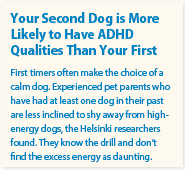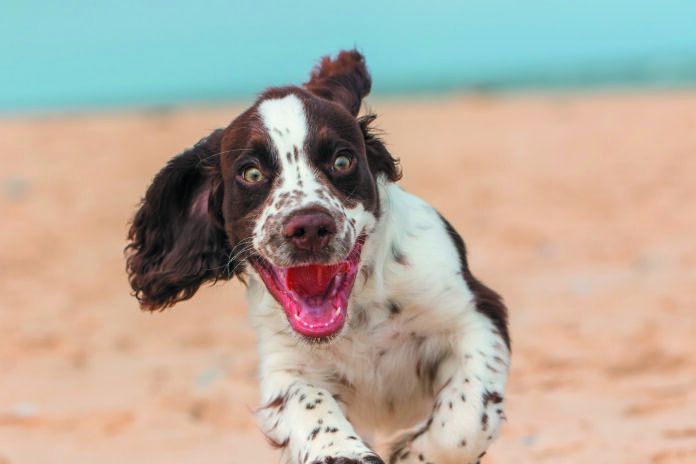Your dog can’t seem to focus too long on much of anything, with the exception of vocalizing 24/7, veering off course to chase bicyclists or joggers, or greeting guests with repeated full-body high-fives in rhythm with your command to “Leave it!” If you’re thinking he might have Attention Deficit Hyperactivity Disorder (ADHD), a neurodevelopmental condition diagnosed in people and characterized not only by hyperactivity but also impulsivity and inattention, you may be right. Findings from a study of 11,000 dogs by researchers at Finland’s University of Helsinki would support your thinking. In other words, our pets are not just being dogs in all cases but may have a cluster of behaviors that point to ADHD-like dysfunction.
Which dogs are most prone?
ADHD in dogs seems very much a combination of nature and nurture.
Nature. Some dogs do seem genetically wired to be predisposed to ADHD, or at least to certain aspects of it. Border collies and German shepherds have relatively high levels of impulsivity, for instance. And rough collies (think Lassie), poodles, and Chihuahuas rate higher in inattention than many of the other 20 breeds evaluated by the researchers.
Some of this is intentional. Breeders select for certain traits in certain breeds. Consider that traditionally, border collies have been needed to race after errant sheep, so of course they had to have an element of impulsivity. Breeding practices can actually shift ADHD-like proclivities. About 70 years ago, long-haired rough collies and short-haired smooth collies were very similar personality-wise; the difference was all in their coats. But when the television show Lassie popularized rough collies, within only a few decades the very high level of energy was bred out of them so they could become more docile companions no longer primed to run around herding farm animals all day.
Along with breed, gender and age appear to influence ADHD-like behavior. Just like with people, male dogs are more likely to have the characteristics. And just like with people, it’s more common in young dogs, including puppies, who then seem to mature in a way that lets them control their urges better.
Nurture. Fortunately for us, even dogs predisposed to having a condition that resembles ADHD can be worked with to attenuate their frenetic and inattentive behavior — and make them happier in the process. The researchers found dogs left alone for long periods were more likely to be described as exuberantly energetic by their human family members than dogs who had more consistent company. In other words, the more time you can spend with your dog — or the more time you can spend engaging with your dog when the two of you are home together — the less likely he will be to act hyper.
ADHD can be worked with to attenuate their frenetic and inattentive behavior — and make them happier in the process. The researchers found dogs left alone for long periods were more likely to be described as exuberantly energetic by their human family members than dogs who had more consistent company. In other words, the more time you can spend with your dog — or the more time you can spend engaging with your dog when the two of you are home together — the less likely he will be to act hyper.
Taking your dog on a few good walks a day helps, of course, as does throwing a ball for him and perhaps playing tug with squeaky toys. But what can also help take the edge off hyperactivity is a class suited to your pet’s particular disposition. Most dogs enjoy agility classes that involve navigating tunnels and other maneuvers. But you can also scratch your dog’s behavioral itch more intentionally. A retriever might like Canine Frisbee competitions; a predatory dog like a whippet may enjoy chasing a plastic bag mechanically set in motion on a lure course. There are even herding classes for dogs bred to chase livestock, including not just border collies but also Australian shepherds, cattle dogs, and corgis.





